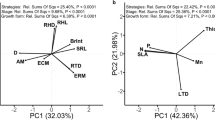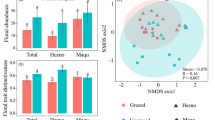Abstract
Phenotypic plasticity has long been suggested to facilitate biological invasions in changing environments, allowing a species to maintain a good ecophysiological performance. High-mountain habitats have been particularly useful for evaluation of the relative importance of environmental conditions in the colonization and invasion process, because they have heterogeneous and stressful climatic conditions, inducing photoinhibition. Light intensity is one of the most changing conditions along altitudinal gradients, showing more variability in higher altitudes. In this study, we analyzed the plasticity in photoprotective strategies and performance of the invasive Taraxacum officinale. Additionally, we tested whether higher plasticity enhances competitive ability in an alpine environment We conducted an experiment to evaluate plasticity with a second generation (F2) of T. officinale individuals from 1,600 to 3,600 m, in a greenhouse with variation in light intensity. Treatments consisted of transferring 120 individuals from each altitude to two conditions of light intensity. We then recorded concentrations of photoprotection pigment, de-epoxidation state of the xanthophyll cycle, foliar angles, photochemical efficiency by fluorescence of photosystem II, total dry biomass and flower production. Additionally, we compared plasticity in both photoprotective and performance traits between T. officinale and the co-occurring native species Hypochaeris thrincioides. Finally, we performed a manipulative experiment under two light regimes in order to assess the competitive outcome between the invasive T. officinale and the native H. thrincioides. Individuals from higher altitude showed significantly greater plasticity than individuals from lower altitude. Similarly, individuals under high light intensity showed higher levels of photoprotective pigments, biomass and flower production. On the other hand, the invasive plant species showed significantly greater plasticity than the co-occurring native species, and a strong negative impact on the biomass of the native plant. Phenotypic plasticity seems to be a successful strategy in T. officinale to compete with native species and may be positively associated with the success of invasions, being greater in individuals from more heterogeneous and stressful environments.






Similar content being viewed by others
References
Abreu ME, Munné-Bosch S (2008) Hyponastic leaf growth decreases the photoprotective demand, prevents damage to photosystem II and delays leaf senescence in Salvia broussonetii plants. Physiol Plant 134:369–379
Alexander JM, Kueffer C, Daehler CC, Edwards PJ, Pauchard A, Seipel T, MIREN Consortium (2011) Assembly of nonnative floras along elevational gradients explained by directional ecological filtering. Proc Nat Acad Sci USA 108:656–661
Alpert P, Simms E (2002) The relative advantages of plasticity and fixity in different environments: when is it good for a plant to adjust? Evol Ecol 16:285–297
Bossdorf O, Lipowsky A, Prati D (2005) Selection of preadapted populations allowed Senecio inaequidens to invade Central Europe. Divers Distrib 14:676–685
Bradshaw A, Hardwick K (1989) Evolution and stress—genotypic and phenotypic components. Biol J Linn Soc 37:137–155
Brock MT, Weinig C, Galen C (2005) A comparison of phenotypic plasticity in the native dandelion Taraxacum ceratophorum and its invasive congener T. officinale. New Phytol 166:173–183
Cavieres LA, Badano EI, Sierra-Almeida A, Gómez-González S, Molina-Montenegro MA (2006) Positive interactions between alpine plant species and the nurse cushions plant Laretia acaulis do not increase with elevation in the Andes of central Chile. New Phytol 169:59–69
Charmantier A, McCleery RH, Cole LR, Perrins C, Kruuk LEB, Sheldon BC (2008) Adaptative phenotypic plasticity in response to climate change in a wild bird population. Science 320:800–803
Davis MA, Grime JP, Thompson K (2000) Fluctuating resources in plant communities: a general theory of invasibility. J Ecol 88:528–534
DeWitt TJ, Scheiner SM (2004) Phenotypic plasticity. Functional and compared approaches. Oxford University Press, New York
Durand LZ, Goldstein G (2001) Photosynthesis, photoinhibition, and nitrogen use efficiency in native and invasive tree ferns in Hawaii. Oecologia 126:345–354
Eckardt NA, Snyder GW, Portis AR Jr, Ogren WL (1997) Growth and photosynthesis under high and low irradiance of Arabidopsis thaliana antisense mutants with reduced ribulose-1, 5-bisphosphate carboxylase/oxygenase activase content. Plant Physiol 113:575–586
García-Plazaola JI, Matsubara S, Osmond CB (2007) The lutein epoxide cycle in higher plants: its relationships to other xanthophyll cycles and possible functions. Funct Plant Biol 34:759–773
Geng YP, Pan XY, Xu CY, Zhang WJ, Li B, Chen JK, Lu BR, Song ZP (2007) Phenotypic plasticity rather than locally adapted ecotypes allow the invasive alligator weed to colonize a wide range of habitats. Biol Invasions 9:245–256
Gianoli E (2002) Maternal environmental effects on the phenotypic responses of the twining vine Ipomoea purpurea to support availability. Oikos 99:324–330
Gianoli E (2004) Plasticity traits and correlations in two populations of Convolvulus arvensis (Convolvulaceae) differing in environmental heterogeneity. Int J Plant Sci 165:825–832
Gianoli E, Molina-Montenegro MA (2005) Leaf damage induces twining in a climbing plant. New Phytol 167:385–390
Grace JB (1995) On the measurement of plant competition intensity. Ecology 76:305–308
Holm L, Doll L, Holm E, Pacheco J, Herberger J (1997) World weeds. Natural histories and distributions. Wiley, New York
Houle G (2002) The advantage of early flowering in the spring ephemeral annual plant Floerkea proserpinacoides. New Phytol 154:689–694
Hulme PE (2008) Phenotypic plasticity and plant invasions: is it all jack? Funct Ecol 22:3–7
IPCC (2007) Intergovernmental Panel of Climate Change. http://www.ipcc.ch
Kilkenny FF, Galloway LF (2008) Reproductive success in varying light environments: direct and indirect effects of light on plants and pollinators. Oecologia 155:247–255
Körner C (2003) Alpine plant life, 2nd edn. Springer, Berlin
Lee CE (2002) Evolutionary genetics of invasive species. Trends Ecol Evol 17:386–391
Matesanz S, Gianoli E, Valladares F (2010) Global change and the evolution of the phenotypic plasticity in plants. Ann N Y Acad Sci 1206:35–55
Maxwell K, Johnson GN (2000) Chlorophyll fluorescence—a practical guide. J Exp Bot 51:659–668
McDowell SCL (2002) Photosynthetic characteristics of invasive and non-invasive species of Rubus (Rosaceae). Am J Bot 89:1431–1438
Molina-Montenegro MA, Cavieres LA (2010) Variación altitudinal de los atributos morfo-fisiológicos en dos especies de plantas alto-andinas y sus implicancias contra la fotoinhibición. Gayana Bot 67:1–11
Molina-Montenegro MA, Badano EI, Cavieres LA (2006) Cushion plants as microclimatic shelters fot two ladybird beetles species in alpine zone of central Chile. Arct Antarct Alp Res 38:224–227
Molina-Montenegro MA, Briones R, Cavieres LA (2009) Does global warming induce segregation among alien and native beetle species in a mountain-top. Ecol Res 24:31–36
Molina-Montenegro MA, Atala C, Gianoli E (2010) Phenotypic plasticity and performance of Taraxacum officinale (dandelion) in habitats of contrasting environmental heterogeneity. Biol Invasions 12:2277–2284
Molina-Montenegro MA, Quiróz CL, Torres-Díaz C, Atala C (2011a) Functional differences in response to drought in the invasive Taraxacum officinale from native and introduced alpine habitat ranges. Plant Ecol Divers 4:37–44
Molina-Montenegro MA, Cleland EE, Watts SM, Broitman BR (2011b) Can a breakdown in competition-colonization trade-offs help explain the success of exotic species in the California flora? Oikos (in press)
Mooney H, Mack R, McNeely J, Neville L, Schei P, Waage J (2005) Invasive alien species: a new synthesis. Island Press, Washington
Munné-Bosch S, Alegre L (2000) Changes in carotenoids, tocopherols and diterpenes during drought and recovery and biological significance of chlorophyll loss in Rosmarinus officinalis plants. Planta 210:925–931
Munné-Bosch S, Peñuelas J (2003) Photo- and antioxidative protection during summer leaf senescence in Pistacia lentiscus L. grown under Mediterranean field conditions. Ann Bot 92:385–391
Muñoz AA, Cavieres LA (2008) The presence of a showy invasive plant disrupts pollinator service and reproductive output in native alpine species only at high densities. J Ecol 96:459–467
Oliveira G, Peñuelas J (2001) Allocation of absorbed light energy into photochemistry and dissipation in a semi-deciduous and an evergreen Mediterranean woody species during winter. Funct Plant Biol 28:471–480
Pérez-Torres E, García A, Dinamarca J, Alberdi M, Gutiérrez A, Gidekel M, Ivanov AG, Huner NPA, Corcuera LJ, Bravo LA (2004) The role of photochemical quenching and antioxidants in photoprotection of Deschampsia antartica. Funct Plant Biol 31:731–741
Pyšek P, Richardson DM (2007) Traits associated with invasiveness in alien plants: where do we stay? In: Caldwell MM (ed) Biological invasions. Springer, Berlin, pp 97–125
Quiróz CL, Choler P, Bapist F, Molina-Montenegro MA, González-Teuber M, Cavieres LA (2009) Alpine dandelion originated in the native and introduced ranges differ in their responses to environmental constraints. Ecol Res 24:175–183
Rejmánek M, Richardson DM, Higgins SI, Pitcairn MJ, Grotkopp E (2005) Ecology of Invasive Plants: State of the Art. In: Mooney HA, Mack RN, McNeely JA, Neville LE, Schei PJ, Waage JK (eds) Invasive alien species a new synthesis. Island Press, Washington, pp 104–161
Richards CL, Bossdorf O, Muth NZ, Gurevitch J, Pigliucci M (2006) Jack of all trades, master of some? On the role of phenotypic plasticity in plant invasions. Ecol Lett 9:981–993
Roux F, Touzet P, Fuguen J, Le Corre V (2006) How to be early flowering: an evolutionary perspective. Trends Plant Sci 11:375–381
Saldaña A, Gianoli E, Lusk CH (2005) Ecophysiological responses to light availability in three Blechnum species (Pteridophyta, Blechnaceae) of different ecological breadth. Oecologia 145:252–257
Sambatti JB, Rice KJ (2007) Functional ecology of ecotypic differentiation in the Californian serpentine sunflower (Helianthus exilis). New Phytol 175:107–119
Schoeppner NM, Relyea RA (2009) Phenotipic plasticity in response to fine-grained environmental variation in predation. Funct Ecol 23:587–594
Sultan SE (2004) Promising directions in plants phenotypic plasticity. Perspect Plant Ecol Evol Syst 6:227–233
Valladares F, Gianoli E, Gomez JM (2007) Ecological limits to plant phenotypic plasticity. New Phytol 176:749–763
van Kleunen M, Fischer M (2001) Adaptive evolution of plastic foraging responses in a clonal plant. Ecology 82:3309–3319
van Kleunen M, Weber E, Fischer M (2010) A meta-analysis of trait differences between invasive and non-invasive plant species. Ecol Lett 13:235–245
Vilà M, Weiner J (2004) Are invasive plant species better competitors than native plant species? - Evidence from pairwise experiments. Oikos 105:229–238
Zar JH (1996) Biostatistical Analysis. Prentice-Hall, Inc., Englewood Cliffs
Acknowledgments
This research was supported by Spanish Government grants CGL2006-04025/BOS, CGL2010-17172, BFU2009-06045-E and Consolider-Ingenio Montes CSD2008-00040 and the Catalan Government grant SGR 2009-458. M.A.M–M. thanks the MECESUP UCO 0214 project and León A. Bravo for providing climatic data.
Author information
Authors and Affiliations
Corresponding author
Rights and permissions
About this article
Cite this article
Molina-Montenegro, M.A., Peñuelas, J., Munné-Bosch, S. et al. Higher plasticity in ecophysiological traits enhances the performance and invasion success of Taraxacum officinale (dandelion) in alpine environments. Biol Invasions 14, 21–33 (2012). https://doi.org/10.1007/s10530-011-0055-2
Received:
Accepted:
Published:
Issue Date:
DOI: https://doi.org/10.1007/s10530-011-0055-2




